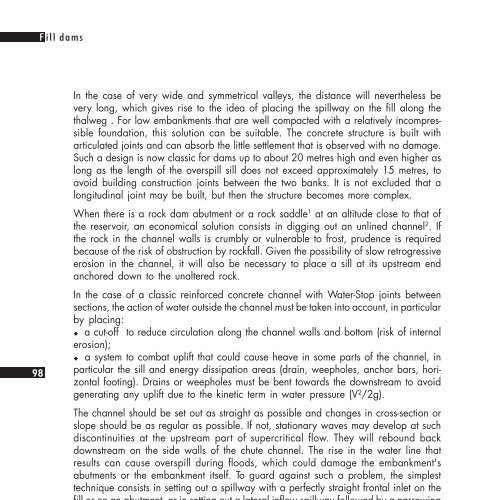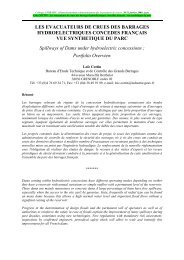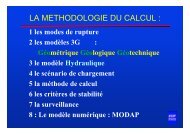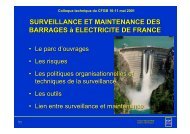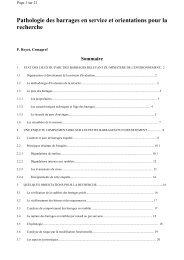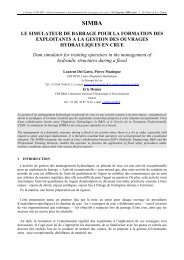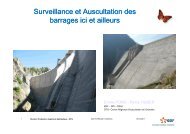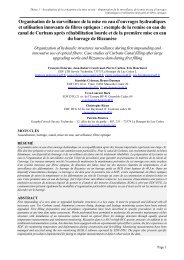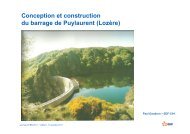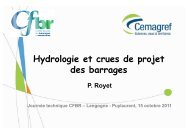SMALL DAMS
SMALL DAMS - Comité Français des Barrages et Réservoirs
SMALL DAMS - Comité Français des Barrages et Réservoirs
- No tags were found...
You also want an ePaper? Increase the reach of your titles
YUMPU automatically turns print PDFs into web optimized ePapers that Google loves.
F ill dams<br />
98<br />
In the case of very wide and symmetrical valleys, the distance will nevertheless be<br />
very long, which gives rise to the idea of placing the spillway on the fill along the<br />
thalweg . For low embankments that are well compacted with a relatively incompressible<br />
foundation, this solution can be suitable. The concrete structure is built with<br />
articulated joints and can absorb the little settlement that is observed with no damage.<br />
Such a design is now classic for dams up to about 20 metres high and even higher as<br />
long as the length of the overspill sill does not exceed approximately 15 metres, to<br />
avoid building construction joints between the two banks. It is not excluded that a<br />
longitudinal joint may be built, but then the structure becomes more complex.<br />
When there is a rock dam abutment or a rock saddle 1 at an altitude close to that of<br />
the reservoir, an economical solution consists in digging out an unlined channel 2 . If<br />
the rock in the channel walls is crumbly or vulnerable to frost, prudence is required<br />
because of the risk of obstruction by rockfall. Given the possibility of slow retrogressive<br />
erosion in the channel, it will also be necessary to place a sill at its upstream end<br />
anchored down to the unaltered rock.<br />
In the case of a classic reinforced concrete channel with Water-Stop joints between<br />
sections, the action of water outside the channel must be taken into account, in particular<br />
by placing:<br />
!"a cut-off to reduce circulation along the channel walls and bottom (risk of internal<br />
erosion);<br />
!" a system to combat uplift that could cause heave in some parts of the channel, in<br />
particular the sill and energy dissipation areas (drain, weepholes, anchor bars, horizontal<br />
footing). Drains or weepholes must be bent towards the downstream to avoid<br />
generating any uplift due to the kinetic term in water pressure (V²/2g).<br />
The channel should be set out as straight as possible and changes in cross-section or<br />
slope should be as regular as possible. If not, stationary waves may develop at such<br />
discontinuities at the upstream part of supercritical flow. They will rebound back<br />
downstream on the side walls of the chute channel. The rise in the water line that<br />
results can cause overspill during floods, which could damage the embankment's<br />
abutments or the embankment itself. To guard against such a problem, the simplest<br />
technique consists in setting out a spillway with a perfectly straight frontal inlet on the<br />
fill or on an abutment, or in setting out a lateral inflow spillway followed by a narrowing<br />
structure with a gentle slope and a straight chute aligned with that structure.<br />
Calculation of the water line (in a steady state for the attenuated design flood flow)<br />
is used to dimension the elevation of the walls, selecting a minimum freeboard of<br />
0.50 metre. It is recommended to do a second calculation for flow with the safety<br />
flood (see Chapter II, p. 25) in order to check that that flood will not cause overspill.<br />
In this way, it can be effectively considered that the safety flood is reached when the<br />
reservoir reaches the crest of the embankment (or if the embankment has a watertight<br />
core, the crest of the latter when the fill above it is permeable).<br />
1. In the case of a saddle at an altitude close to that of the reservoir, see chapter III, Feasibility study,<br />
stage 2, p. 54.<br />
2. Unlined channels require greater surveillance. They are not recommanded if the rock is cracked.


